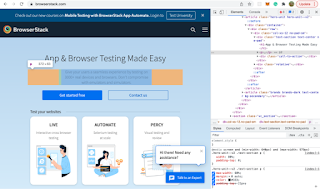Module 47: Testing HTML in Different Browsers
Introduction
When developing web pages, ensuring compatibility across different browsers is crucial. Since different browsers render HTML, CSS, and JavaScript differently, rigorous cross-browser testing is necessary to deliver a seamless user experience.
1. Importance of Cross-Browser Testing
Why Test HTML in Different Browsers?
Different browsers interpret HTML, CSS, and JavaScript uniquely.
Users access websites on different devices, operating systems, and browser versions.
Inconsistencies can lead to broken layouts, misaligned elements, or malfunctioning scripts.
Common Browser Rendering Differences
CSS Handling: Fonts, shadows, flexbox, and grid layouts may appear differently.
JavaScript Execution: Some older browsers may not support ES6+ features.
Rendering Engine Variations: Browsers use different engines (e.g., Chrome: Blink, Firefox: Gecko, Safari: WebKit).
2. Testing Strategy for Cross-Browser Compatibility
Step 1: Identify Target Browsers
Analyze user analytics to determine commonly used browsers.
Consider popular browsers:
Google Chrome (Blink)
Mozilla Firefox (Gecko)
Apple Safari (WebKit)
Microsoft Edge (Blink)
Opera (Blink)
Internet Explorer (Legacy support if necessary)
Step 2: Define Testing Methods
Manual Testing: Open the website in multiple browsers and check for visual or functional discrepancies.
Automated Testing: Use browser testing tools to automate compatibility checks.
Step 3: Conduct Cross-Browser Testing
Method 1: Manual Testing (Basic)
Open the HTML file in each browser.
Check visual elements such as fonts, colors, and layouts.
Interact with buttons, forms, and navigation to test functionality.
Method 2: Using Developer Tools
Chrome DevTools, Firefox Developer Tools, Safari Web Inspector:
Inspect elements, test responsiveness, and debug JavaScript errors.
Change user agents to simulate different browsers.
Method 3: Online Cross-Browser Testing Tools
BrowserStack, LambdaTest, Sauce Labs:
Test websites on multiple real browsers and devices.
Detect rendering issues without installing different browsers manually.
Method 4: Automated Testing with Selenium
Selenium can automate browser testing with test scripts.
Example Python script using Selenium:
from selenium import webdriver
# Initialize browser drivers
browsers = ["chrome", "firefox"]
for browser in browsers:
if browser == "chrome":
driver = webdriver.Chrome()
elif browser == "firefox":
driver = webdriver.Firefox()
driver.get("https://example.com")
print(f"Testing {browser}: Page title is {driver.title}")
driver.quit()
3. Handling Browser-Specific Issues
Common Issues and Fixes
Issue Cause Fix
Different font rendering Browser-specific font smoothing Use font-smoothing properties
Flexbox/grid layout differences Browser rendering quirks Add -webkit-, -moz- prefixes
JavaScript ES6 errors Older browsers don’t support ES6 Use Babel to transpile code
CSS animations not working Browser-specific implementation Use @keyframes with prefixes
Using Feature Detection Instead of Browser Detection
Instead of detecting a browser directly (which can be unreliable), use feature detection with Modernizr:
<script src="https://cdnjs.cloudflare.com/ajax/libs/modernizr/2.8.3/modernizr.min.js"></script>
<script>
if (Modernizr.flexbox) {
console.log("Flexbox supported!");
} else {
console.log("Flexbox NOT supported!");
}
</script>
4. Practical Exercises
Exercise 1: Manual Testing on Browsers
Open your HTML project in at least 3 different browsers.
Identify any design inconsistencies.
Document the differences and propose fixes.
Exercise 2: Using DevTools to Debug
Open Chrome DevTools (F12 or right-click > Inspect).
Simulate another browser (Device Toolbar > User Agent).
Fix any rendering issues found in the Elements tab.
Exercise 3: Running Automated Tests with Selenium
Install Selenium:
pip install selenium
Modify the provided Python script to test multiple pages.
Observe the results and fix detected issues.
5. Conclusion
Cross-browser testing ensures a consistent user experience.
Combining manual and automated testing improves efficiency.
Using online tools and automation frameworks can speed up debugging.
By following this module, learners will develop strong cross-browser testing skills and understand how to create robust, browser-compatible web applications.







No comments:
Post a Comment